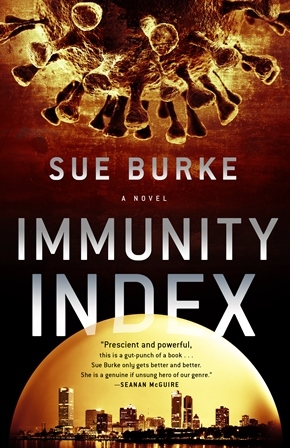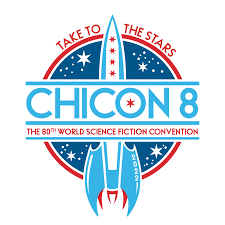Sue Burke's Blog, page 20
May 11, 2022
My choice for the Nebula Award for Novelette

As a member of SFWA, the Science Fiction and Fantasy Writers Association, I can vote for the Nebula Awards. Usually I focus on the shorter works — short stories, novelettes, and novellas — due to time constraints and because these categories tend to attract fewer voters, so my vote matters more.
The 57th Annual Nebula Awards will be presented on May 21 during the Nebula Conference Online. Although the conference is for paid attendees, the award presentation will be live-streamed.
A novelette, according to the Nebula rules, is at least 7,500 words but fewer than 17,500 words. There’s more depth than a short story but many of the same constraints. Here’s a brief evaluation of each finalist, ending with my choice, but every story is worth reading, and I had a hard time picking only one.
“O2 Arena” by Oghenechovwe Donald Ekpeki (Galaxy’s Edge 11/21) – In a dystopic Nigeria, a law student decides that survival is overrated. “This world needs a wake-up call that might be only found in an arena of our own making.” Taut and gritty.
“(emet)” by Lauren Ring (F&SF 7–8/21) – “Emet” means truth in Hebrew. An IT worker finds the path to truth runs through golems, and self-discovery leads to a very reasonable paranoia. Timely issues add to the depth of the story.
“That Story Isn’t the Story” by John Wiswell (Uncanny 11–12/21) – A terrified young man overcomes his fears, just barely, of a vampire. The story is really a beautiful tribute to friendship.
“Colors of the Immortal Palette” by Caroline M. Yoachim (Uncanny 3–4/21) – An immortal painter struggles with art, recognition, and meaning. Quiet and philosophical.
“Just Enough Rain” by PH Lee (Giganotosaurus 5/21) – God is lonely and gets involved in a woman’s life, but God doesn’t plan ahead very well. I laughed out loud. This gets my vote because there’s never enough humor in speculative fiction and because I need a reason to pick just one story for my vote, so laughter wins. Any of the stories is worthy of the award.
May 4, 2022
My choice for the Nebula Award for Short Story

As a member of SFWA, the Science Fiction and Fantasy Writers Association, I can vote for the Nebula Awards. Usually I focus on the shorter works — short stories, novelettes, and novellas — due to time constraints and because these categories tend to attract fewer voters, so my vote matters more.
The 57th Annual Nebula Awards will be presented on May 21 during the Nebula Conference Online. Although the conference is for paid attendees, the award presentation will be live-streamed.
The nominees for short story present a solid ballot. I’m frustrated that I can only vote for one because a six-way tie isn’t an option. Here’s a brief evaluation of each finalist, ending with my choice, but every story is worth reading, and your choice might be different.
“Let All the Children Boogie” by Sam J. Miller (Tor.com 1/6/21) – Two misfit teenagers meet and fall in love as they try to find the source of some mysterious radio interference. Intense emotion faces the unknown in a hostile environment, but with 21st century values in a 20th century setting. The ending sort of fades away, but the story lingers.
“For Lack of a Bed” by John Wiswell (Diabolical Plots 4/21) – As someone with arthritis, I love the way this story centers on chronic pain and a supernatural cure. I’d give a lot for that bed. I also love the way friends help each other out. Overall, a heartwarming story about the importance of friendship.
“Mr. Death” by Alix E. Harrow (Apex 2/21) – No spoilers, but this story is sweet, heartfelt, and lovely, which I didn’t see coming. A Junior Reaper of Death must take a toddler “across the river” to join the cosmos, and it’s just too hard.
“Laughter Among the Trees” by Suzan Palumbo (The Dark 2/21) – An intense horror story about a sister who gets lost in the woods. Complex emotions are skillfully portrayed, especially survivor guilt.
“Proof by Induction” by José Pablo Iriarte (Uncanny 5–6/21) – A son and a simulacrum of his father work together after the father’s death to solve a mathematics hypothesis, a process that isn’t emotionally satisfying for the son. The story was emotionally moving to me as a reader, though.
“Where Oaken Hearts Do Gather” by Sarah Pinsker (Uncanny 3–4/21) – An online group debates and investigates the meaning of a traditional song. The storytelling format is untraditional and effective. This is my pick because I like to reward experimentation.
April 27, 2022
My woolly mammoth ivory

I own a few bits of woolly mammoth ivory. Although the sale of ivory from elephants is restricted and highly controversial, woolly mammoth ivory is unrestricted and provokes few worries.
That’s because elephants are listed as threatened with extinction by CITES (the Convention on International Trade in Endangered Species of Wild Fauna and Flora), and despite conservation efforts, illegal trade continues. Woolly mammoths, however, went extinct about 10,000 years ago. No mammoths are killed to obtain ivory because they’re already dead, so woolly mammoth ivory remains relatively easy to buy and somewhat affordable.
My ivory came from Alaska, and I bought it from a jeweler. He had bought a piece of tusk that came with a bark-like crust, the result of thousands of years of aging, which he’d stripped off and was selling for 25 cents per gram, since he had no use for it.
I’m still deciding what to do with it. It looks a lot like tree bark but feels and weighs more like stone, since it’s basically a mineral that our bodies can produce: a tooth. I’m thinking of using it to make jewelry that puts its rough aesthetics to artistic advantage.
I bought the ivory because a woolly mammoth plays a role in my novel Immunity Index — specifically, a mammoth recreated by genetic engineering. While the novel largely deals with other issues, it mentions a few of the problems with mammoth de-extinction. For example, mammoths, like elephants, led highly social lives. If we want to bring them back humanely, we need to bring back many large herds of them. In the book, that wasn’t done.
***
A trade paperback edition of novel Immunity Index, goes on sale May 17. Read an excerpt here. Read a different excerpt here.
Reader review: “Already a fan after the fascinating Semiosis books but this one was even tighter. Set in the middle of the confusion of a pandemic, misinformation, helplessness, and a civil uprising, and yet manages to be wholesome and uplifting. 5 star”
April 20, 2022
Barnes & Noble preorder special for “Immunity Index”

You can pre-order the trade paperback edition of “Immunity Index” for 25% off from today to Friday, April 20 to 22, at Barnes & Noble. Coupon code: PREORDER25
Immunity Index: a novel by Sue Burke, Paperback | Barnes & Noble
April 13, 2022
The scary fallibility of algorithms
The scary fallibility of algorithms:

April 6, 2022
Come to Chicon 8!

Chicon 8, the 80th World Science Fiction Convention, will be held in Chicago from September 1 to 5, 2022.
I’ll be there. In fact, I’m already doing a little volunteer work for the convention, helping edit the Progress Reports. Progress Report 3 is just out (PDF here), and I have an article in it about Chicon 8’s logo, the rocket that will “take it to the stars.” The logo is based on the Chicago city flag.
Progress Report 3 also includes a report about the first Worldcon in 1939, an article about fandom, a report from the convention chair, and news about the Art Show, Dealers’ Room, Exhibits, Hospitality, Member Services, and Programming. If you’re not sure if you want to attend, this might tempt you. Exciting things are in the works!
As Convention Chair Helen Montgomery puts it: “We really cannot wait to bring you all to Chicago, to show off our city and our fandoms, and to share our love of science fiction and fantasy together. Help us make our dreams, and yours, reality.”
I also have an article in Progress Report 2 (PDF here) about the Chicago city flag. Each of the four stars on the flag represents an important event in the city’s history.
As I said, I’ll be at Chicon 8. I plan to hop on a bus in front of my house, hop off the bus twenty minutes later, and be ready for five days of fun and inspiration with thousands of fellow writers and fans.
March 30, 2022
Goodreads review: “The First Five Pages”
The First Five Pages: A Writer’s Guide To Staying Out of the Rejection Pile by Noah Lukeman
My rating: 4 of 5 stars
If you want to write a novel, The First Five Pages should be helpful, although with a couple of minor caveats.
The book starts at the sentence level and carefully considers individual word choices, offering both basic and sophisticated advice. For example, comparisons slow down a text — which can be good or bad, depending on the pacing the author needs.
The second half of the book looks at “big picture” concerns like pacing, setting, and characterization. These can raise a novel from good to great. Some of Lukeman’s lessons might be familiar but reminders won’t hurt, and other lessons might be new and necessary.
Two caveats: First, the opening chapter, Presentation, is laughably out of date. Submissions are electronic these days, via email or website, and would-be authors need advice for how to handle those formats, not warnings about dot-matrix printers. Second, the examples of what not to do are so over-the-top bad that they rarely teach the would-be writer very much.
Beyond that, which are small problems, I think the book is worth the investment of money and time. Noah Lukeman knows that writing is hard, and he offers not just good advice but consistent encouragement.
View all my reviews
March 23, 2022
My Goodreads review of “Time Waits for No One” by Steve Bellinger
 Time Waits For No One: The Chronocar Chronicles by Steve Bellinger
Time Waits For No One: The Chronocar Chronicles by Steve BellingerMy rating: 5 of 5 stars
Steve Bellinger takes the time travel paradox seriously. Time Waits for No One is the sequel to The Chronocar, which won several awards. In The Chronocar, a young black man in Chicago, Tony Carpenter, builds a time-travel machine and goes back to 1919, where things go deadly wrong. That was the year of the “Red Summer” riots by white supremacists.
In the sequel, Tony is time traveling again, a different Tony in a different timeline, and things go wrong in a different and even more deadly way.
The story moves fast, with both serious and funny moments, but eventually Tony has to take responsibility for catastrophes that he might not be able to solve. As with The Chronocar, I especially recommend this book to YA readers.
Oh, and about halfway through the book, the Earth is destroyed. I always enjoy it when that happens in a story. But this is time travel, so maybe the Earth can be rescued…
View all my reviews
March 16, 2022
“Who Loved Their Babies More”

“The motherhood statement,” according to the Turkey City Lexicon, “affirms the conventional social and humanistic pieties, i.e. apple pie and motherhood. Greg Egan once stated that the secret of truly effective SF was to ‘deliberately burn the motherhood statement.’”
This is my attempt to burn the motherhood statement. It was originally published in Thema, Paper Tigers anthology, Vol. 15, No. 1, Spring 2003.
***
The mosquito landed on the woman’s arm, she slapped it, and it fell dead. But nothing happens so easily.
She had watched it hover, tiger-striped. It landed on insubstantial legs, delicate as a fairy queen. Only females sought blood, and after a blood meal it could lay eggs. The woman considered granting its wish. Even tiny lives mattered.
But she couldn’t. The mosquito might carry a disease — not that it would care, even if it could understand. Its eggs mattered more to it than any human life. Mercy did not fit into the equation for either of them. The woman was pregnant. She had a life to protect, too. She slapped, and the mosquito fell, its long striped legs crushed and tangled.
And yet, she knew that with trillions of mosquitos and billions of humans in the world, this single killing accomplished almost nothing. It proved nothing, not even who loved their babies more. She had the brute advantage this time and she took it, that was all. Next time, who knew?
She eyed the tiny corpse on the ground. Only fools believed that motherhood meant tenderness. Motherhood meant menace. Motherhood made enemies. Mothers would stop at nothing. And she hadn’t even given birth yet.
© Sue Burke 2003
March 9, 2022
Cultural appropriation: a cautionary tale

The term cultural appropriation has a few definitions, but all contain the idea of members of one culture using elements of another culture, particularly the exploitation and distortion of those elements. Among the ways to misappropriate a culture, you might err because you don’t fully understand that culture, even if you’re sure you do.
Here’s an example. When I was living in Spain, I belonged to an English-language writers critique group, and members came from a variety of countries. For some of them, the United States was a far-off, exotic land, and occasionally they tried to write stories and poems set there. Sometimes they failed spectacularly.
A little background: I was born and grew up in the United States. My father, shown in the photo, played on Marquette University’s football team. Wherever you’re from, you probably know that the sport called “football” in most of the world and “soccer” in the United States is very different from the sport we call “football” in the United States, even though they share historic roots. I’m a casual fan of American-style gridiron football, and I know a few things about it.
One day, an Irish author in our critique group submitted the start of a novel with this conflict: a young man in Chicago wants to play college football, but his father disapproves of anything that would detract from his studies for medical school, so the young man hides his participation in the Northwestern University football team.
The author was a big fan of soccer, and he assumed that American gridiron football would be similar. Wrong, wrong, wrong.
To start with, the author did not understand how hard, how treasured, and how public a spot on Northwestern’s team is. In fact, it’s a Big Ten team, the stuff of legend. Player recruitment involves years of preparation, the whole family, scholarships, sometimes lawyers and agents, and very often intense media attention.
After one game in which the young man in the novel makes a key play, he’s worried his father might find out about his deception, but, he reasons, no one pays much attention to college sports; apparently college sports don’t get much attention in Ireland. In fact, Northwestern games are televised live and covered by the news media in excruciating detail.
In one scene, the player talks to the coach, an underpaid, unimportant man who works out of a grim, tiny office in a basement corner of the school gym. In fact, the Northwestern football program is located in a fieldhouse that could be described as palatial. The current coach, Pat Fitzgerald, reportedly earns $5 million per year and could be described as fairly well known.
The coach orders the young man to “get kitted up and go out on the pitch.” In fact, American football is played in what we call uniforms and on what we call a field.
In one game, the play is described as moving fluidly up and down the pitch, now advancing, now protecting the goal. In fact, American football has been described as controlled violence interrupted by frequent committee meetings (huddles), very stop-and-start, and there are separate offensive and defensive teams as well as special teams.
Clearly, our author had never seen an American football game, but it’s a lot like soccer, right?
I tried to be gentle as I advised the author to abandon his novel. He would never be able to do enough research from his home in Spain to get the details right.
Cultures are complex. It’s easy to blunder. If you want to write about something from another culture, perhaps you can successfully, but the first step is understanding the other culture and yourself. American football is tough enough to withstand a lot of misappropriation. The elements of some other cultures might be fragile and should be approached with care and respect. In fact, you might even discover that you aren’t the right author for that story.
Even though I live in Chicago now and I’ve known some real-life American football players, I’m not qualified to write a novel about a member of the Northwestern University football team. I know more than enough about American football and Northwestern to understand how very little I actually know.



